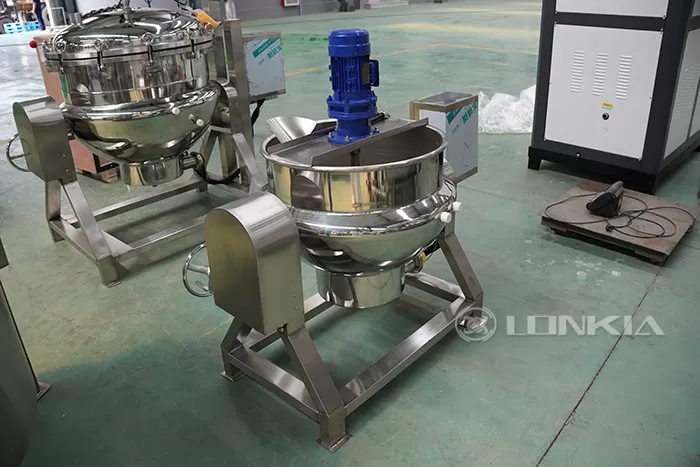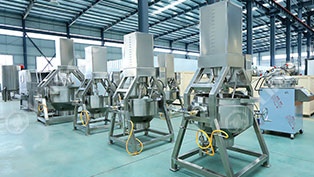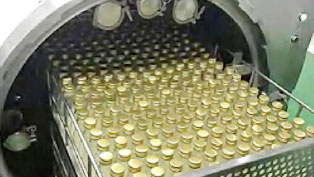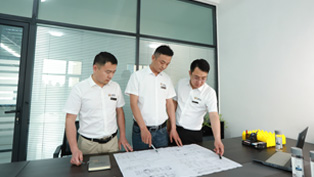In commercial food processing, catering, and industrial kitchens, achieving precise, uniform cooking is essential for producing high-quality sauces, soups, dairy products, confectionery, and more. A jacketed kettle pot is one of the most efficient cooking vessels for even heating, temperature control, and batch processing.
But what exactly is a jacketed kettle pot, and how does it work? In this article, we’ll explore its design, functionality, benefits, and applications in the food industry.
🔹 1. What Is a Jacketed Kettle Pot?
A jacketed kettle pot is a specialized cooking vessel with a double-layered (jacketed) construction that allows indirect heating using steam, water, or thermal oil. Unlike traditional pots, which apply heat only from the bottom, a jacketed kettle pot ensures uniform heat distribution around the entire cooking surface.
✅ Key Features of a Jacketed Kettle Pot:
✔ Double-layered jacket design for efficient heat transfer.
✔ Steam, water, or oil heating options for precise temperature control.
✔ Tilting or stationary models for easy product handling.
✔ Integrated stirring mechanism (in some models) for consistent mixing.
✔ Durable stainless steel construction for hygiene and longevity.
🔹 Example:
A soup manufacturer uses a jacketed kettle to maintain a consistent cooking temperature, preventing burning or uneven cooking.

🔹 2. How Does a Jacketed Kettle Pot Work?
✅ Step-by-Step Working Process:
1️⃣ Heating Medium Circulation:
- Steam, hot water, or thermal oil is introduced into the outer jacket layer of the kettle.
- This indirect heating prevents scorching and ensures even temperature distribution.
2️⃣ Uniform Heat Transfer:
- The heat circulates around the inner pot, cooking the contents evenly.
- Temperature is precisely controlled for delicate food products like dairy or confectionery.
3️⃣ Optional Stirring Mechanism:
- Some kettles come with planetary stirring systems to prevent sticking.
- Ideal for thick products like sauces, caramel, and mashed potatoes.
4️⃣ Tilting or Discharge:
- Tilting models allow easy pouring of cooked food.
- Fixed models have bottom discharge valves for smooth product flow.
🔹 Example:
A confectionery company uses a steam jacketed kettle to melt chocolate and caramel evenly without burning.
🔹 3. Benefits of Using a Jacketed Kettle Pot
✔ 1. Uniform Cooking & Temperature Control
✅ Prevents hot spots, burning, or uneven heating.
✅ Ideal for sensitive recipes like dairy, sauces, and syrups.
✅ Precise temperature adjustment for consistent cooking results.
✔ 2. Increased Efficiency & Faster Cooking
✅ Steam or thermal oil heating reduces cooking time compared to traditional pots.
✅ High heat transfer efficiency improves batch productivity.
✔ 3. Versatile for Various Food Applications
✅ Suitable for soups, sauces, candies, jams, dairy, and ready-to-eat meals.
✅ Works with liquid and semi-solid foods.
✔ 4. Hygienic & Easy to Clean
✅ Stainless steel construction prevents contamination and meets food safety standards.
✅ Some models come with CIP (Clean-in-Place) systems for automated cleaning.
✔ 5. Reduces Labor & Manual Stirring
✅ Integrated stirring mechanisms minimize labor-intensive mixing.
✅ Tilting function makes it easy to empty cooked products.
🔹 Example:
A sauce production facility increased efficiency by 40% after switching to a jacketed kettle with an automated stirring system.
🔹 4. Applications of Jacketed Kettle Pots in the Food Industry
🏭 Food Processing Plants
✔ Large-scale production of soups, sauces, and dairy products.
🍽️ Central Kitchens & Catering Services
✔ Efficient batch cooking for restaurants, hotels, and meal prep services.
🍬 Confectionery & Dairy Processing
✔ Ideal for chocolate melting, caramelization, and yogurt production.
🛒 Canned & Packaged Food Manufacturing
✔ Used for preserving and pre-cooking food products before packaging.
🔹 Example:
A dairy company uses jacketed kettles to pasteurize milk and prepare cheese sauces.
🔹 5. How to Choose the Right Jacketed Kettle Pot for Your Business
✅ 1. Capacity & Batch Size
✔ Small kettles (50-100L) → For small-scale kitchens.
✔ Large kettles (300-1000L+) → Ideal for industrial food production.
✅ 2. Heating Method
✔ Steam jacketed kettles – Best for fast, high-temperature cooking.
✔ Electric-heated kettles – Suitable for smaller operations.
✔ Gas-heated kettles – Cost-effective for continuous production.
✅ 3. Tilting vs. Stationary Models
✔ Tilting kettles – Easier to discharge liquids and semi-solids.
✔ Stationary kettles – Often have bottom discharge valves for automation.
✅ 4. Stirring Mechanism
✔ Planetary stirring – Best for thick sauces and pastes.
✔ Scraper stirring – Prevents burning and sticking.
✅ 5. Food Safety & Material Quality
✔ 304/316 Stainless Steel Construction – Meets HACCP & FDA standards.
✔ Easy-to-clean surfaces – Ensures hygiene compliance.
🔹 Example:
A soup manufacturer chose a 500L steam-jacketed kettle with a tilting feature for high-speed batch cooking.
🔹 Conclusion: Why Invest in a Jacketed Kettle Pot?
For businesses involved in food production, catering, and large-scale cooking, a jacketed kettle pot is an essential investment that improves efficiency, consistency, and food safety.
🔑 Key Takeaways:
✅ Uniform heat distribution prevents burning and ensures consistency.
✅ Energy-efficient and high-capacity processing for commercial food production.
✅ Versatile for soups, sauces, dairy, confectionery, and ready-to-eat meals.
✅ Customizable options (tilting, stirring, steam/electric heating) for different needs.
At LONKIA Machinery, we offer high-quality jacketed kettles tailored for food manufacturers, commercial kitchens, and industrial food processors. Contact us today to find the best solution for your cooking needs! 🚀



